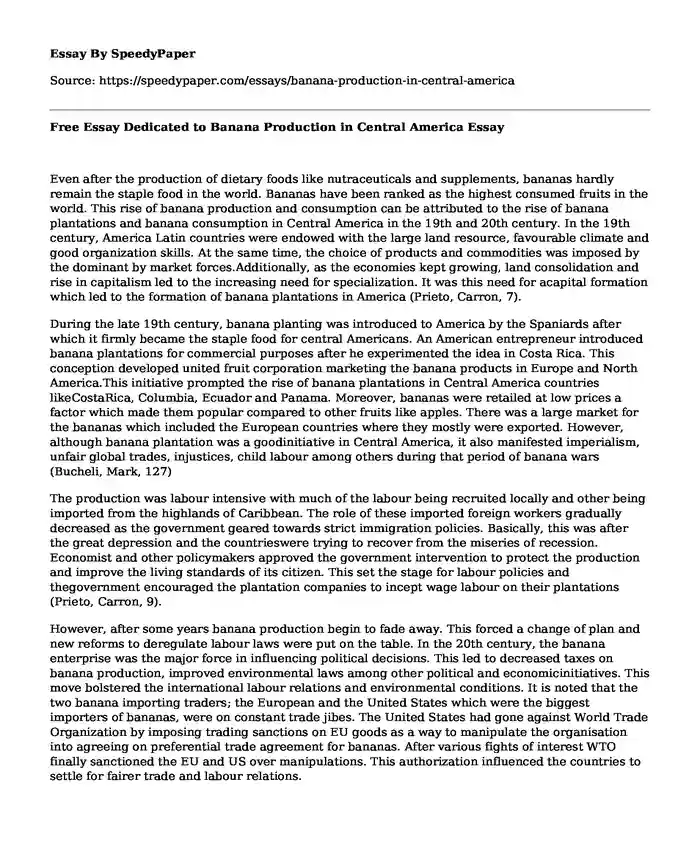Even after the production of dietary foods like nutraceuticals and supplements, bananas hardly remain the staple food in the world. Bananas have been ranked as the highest consumed fruits in the world. This rise of banana production and consumption can be attributed to the rise of banana plantations and banana consumption in Central America in the 19th and 20th century. In the 19th century, America Latin countries were endowed with the large land resource, favourable climate and good organization skills. At the same time, the choice of products and commodities was imposed by the dominant by market forces.Additionally, as the economies kept growing, land consolidation and rise in capitalism led to the increasing need for specialization. It was this need for acapital formation which led to the formation of banana plantations in America (Prieto, Carron, 7).
During the late 19th century, banana planting was introduced to America by the Spaniards after which it firmly became the staple food for central Americans. An American entrepreneur introduced banana plantations for commercial purposes after he experimented the idea in Costa Rica. This conception developed united fruit corporation marketing the banana products in Europe and North America.This initiative prompted the rise of banana plantations in Central America countries likeCostaRica, Columbia, Ecuador and Panama. Moreover, bananas were retailed at low prices a factor which made them popular compared to other fruits like apples. There was a large market for the bananas which included the European countries where they mostly were exported. However, although banana plantation was a goodinitiative in Central America, it also manifested imperialism, unfair global trades, injustices, child labour among others during that period of banana wars (Bucheli, Mark, 127)
The production was labour intensive with much of the labour being recruited locally and other being imported from the highlands of Caribbean. The role of these imported foreign workers gradually decreased as the government geared towards strict immigration policies. Basically, this was after the great depression and the countrieswere trying to recover from the miseries of recession. Economist and other policymakers approved the government intervention to protect the production and improve the living standards of its citizen. This set the stage for labour policies and thegovernment encouraged the plantation companies to incept wage labour on their plantations (Prieto, Carron, 9).
However, after some years banana production begin to fade away. This forced a change of plan and new reforms to deregulate labour laws were put on the table. In the 20th century, the banana enterprise was the major force in influencing political decisions. This led to decreased taxes on banana production, improved environmental laws among other political and economicinitiatives. This move bolstered the international labour relations and environmental conditions. It is noted that the two banana importing traders; the European and the United States which were the biggest importers of bananas, were on constant trade jibes. The United States had gone against World Trade Organization by imposing trading sanctions on EU goods as a way to manipulate the organisation into agreeing on preferential trade agreement for bananas. After various fights of interest WTO finally sanctioned the EU and US over manipulations. This authorization influenced the countries to settle for fairer trade and labour relations.
In conclusion, the banana plantation is not only viewed as a source of food and malnourishment remedy. Banana plantation, in essence, has resulted in many reforms including trade, labour and environment reforms. The banana wars have influenced global trading making the trading laws fairer. It has also improved the labour and environmental relations between countries with favourable agreements. Finally, it has also addressed the child labour problem which was the main debatable topic between plantation companies and the humanitarians.
Work Cited
Prieto, Carron. "Corporate social responsibility in Latin America: Chiquita, women banana workers and structural inequalities". Journal of Corporate Citizenship (jcc), 21, (2006). 1-10.
Bucheli, Mark. "Bananas and business: The United Fruit Company in Colombia, 1899-2000". New York: New York University Press. 2015. Print.
Cite this page
Free Essay Dedicated to Banana Production in Central America. (2022, Mar 22). Retrieved from https://speedypaper.com/essays/banana-production-in-central-america
Request Removal
If you are the original author of this essay and no longer wish to have it published on the SpeedyPaper website, please click below to request its removal:
- Essay Example: Conversation vs. Speeches
- Essay Exampe on Working Conditions for Children in Textile Mills
- Education Essay Sample: Communicative Language Teaching
- Free Essay Describing the Influence of China in Africa
- Dissertation Help for Impeccable Results, Free Paper
- The Truman Show - Movie Review Example
- Income Distribution Essay Sample
Popular categories





